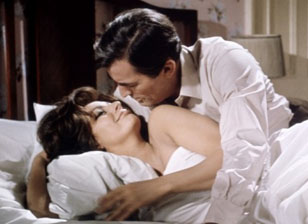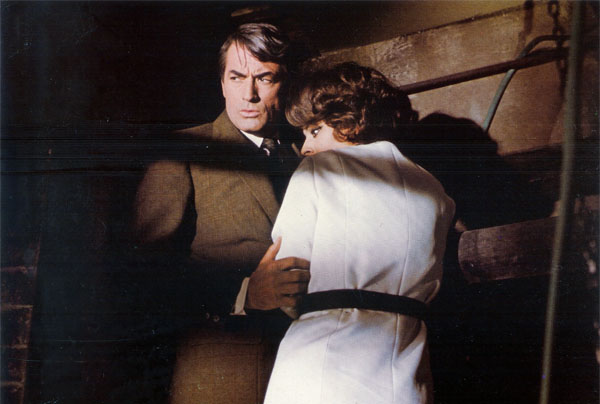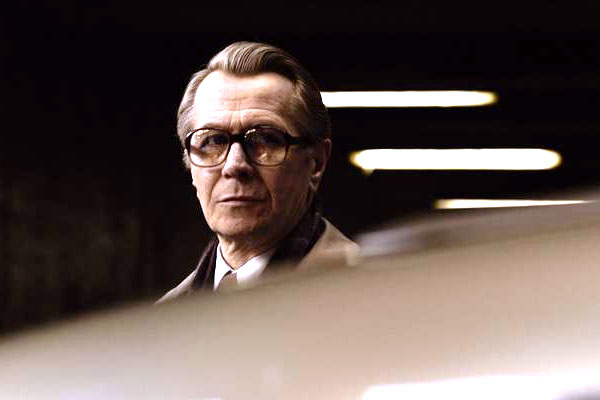Arabesque (1965, Dir. Stanley Donen):
Once upon a time, froth was not only a fun thing but a good thing. You know, back before diets, back when silly could be seen in public with sophisticated, when glamour was actually meant to be glamorous…
 All right, maybe a bit of exaggeration there. We tend to romanticize the past, and cinema has always been about the act of nostalgia, the privileging of the past over the present. But it’s not a stretch to note that when it comes to the “caper” movie as we’ve come to treasure it, they just don’t make ’em like they used to. (Or when they do, they’re studious remakes like Soderbergh’s Oceans Eleven or Demme’s The Truth About Charlie.) Maybe the reason movies like Arabesque work has nothing to do with their worth as works of art, and everything to do with how the camera happens to catch the glitter in Sophia Loren’s eyes.
All right, maybe a bit of exaggeration there. We tend to romanticize the past, and cinema has always been about the act of nostalgia, the privileging of the past over the present. But it’s not a stretch to note that when it comes to the “caper” movie as we’ve come to treasure it, they just don’t make ’em like they used to. (Or when they do, they’re studious remakes like Soderbergh’s Oceans Eleven or Demme’s The Truth About Charlie.) Maybe the reason movies like Arabesque work has nothing to do with their worth as works of art, and everything to do with how the camera happens to catch the glitter in Sophia Loren’s eyes.
Which is to say to Arabesque is a sugary treat that’s light on nutrition but satisfyingly low on fat. A variation on Stanley Donen’s Charade (1963), in which Cary Grant and Audrey Hepburn give each other goo-goo eyes in between getting hunted by thieves, scoundrels and killers through the streets of gay Paris, Arabesque freely cribs from the hot (James Bond), the popular (Hitchcock) and the cool (psychedelia). As with Charade, an innocent (Egyptology expert Pollock, played by Gregory Peck) is thrown into a world of international intrigue and deceit, the standard “wrong man in the wrong place” – a scenario perfected by Hitchcock. (There’s a clear steal from North by Northwest when a drugged Pollock finds himself in the middle of a very busy highway.) As in Charade, our hero is befriended by an enticing ally who may or may not be trustworthy (Grant’s man of a half-dozen names in Charade; here it’s Sophia Loren as the villain’s mistress — or is she a freedom fighter? Or maybe the daughter of a cruel military dictator?), and before you can say “McGuffin” the thinnest of plots unravels into a riot of bravura set pieces, topped off with witty banter, actors in brownface (the baddies are from the Middle East, don’tcha know), some alluring Henry Mancini music, and all the latest fashions and hot spots (in this case, Christian Dior and a London swept up in the swinging ’60s).
 “There’s nothing like a little kidnapping now and then to keep the circulation going.”
“There’s nothing like a little kidnapping now and then to keep the circulation going.”
— Gregory Peck, Arabesque
Does any of it matter? Of course not, and Arabesque nearly makes the mortal mistake of being too self-conscious about that fact. Peck might have fun sending up his typical stuffed-shirt image, but it should come as no surprise that he’s no Cary Grant when it comes to repartee, and he’s too wary a presence to fall in comfortably with the shenanigans. He has good reason to be ill at ease, though — the plot is a lot of humpty-dumpty about an assassination attempt and coded hieroglyphics, with one unlikely scrape after another. Where Charade coasted by on the charisma on its leads and the zip of Peter Stone’s dialogue, Arabesque can only muster a few zingers between Peck and Loren that are more fizz than pop. Donen, all too aware of the script’s shortcomings, advised cinematographer Christopher Challis, “Our only hope is to make it so visually exciting that the audience will never have time to work out what the hell is going on.”
And damned if they don’t pull it off, with see-sawing tracking shots, off-kilter framing, restless handheld work, and riots of Technicolor. It’s never over-indulgent, though — these set pieces have the precision of a musical (no surprise coming from the man behind Singing in the Rain). A nocturnal chase through the London Zoo becomes a phantasmagoria of growling faces both animal and human, reflections in glass cages pursuing each other. A confrontation between agents amidst the crowds at the Ascot Races is as lush as cotton candy. A final pursuit involving horses, a helicopter and a bridge bounds past believability but one will be loathe to care amidst the soaring shots from above and the sight of green English countryside running in all directions. Even the simple flight of Peck and Sophia down a staircase is filmed through a chandelier, their bodies sliced and refracted and recombined second by second. The title “Arabesque” might be a semi-humorous pun on the Middle Eastern thrust of the plot, but Challis’s whirling dervish of a camera certainly justifies it.
 Did we mention Sophia Loren? In a film chock full of ciphers, she is the most unreadable of them all, and in a movie that approaches abstract art, she is the centerpiece. Whether getting surprised in a bathtowel or kicking back her legs as she tries on new heels or making pillow eyes, she floats through the movie like the wind, touching down long enough to entrance Peck (and us). Arabesque is stuffed with innuendo, but flirting gives way to the silly sincerity of ’60s romance when Peck and Loren finally bed down. As she gazes up at him with tousled hair and the wisp of a smile and Peck seriously considers marrying her, we smile at the absurdity and rightness of the thought. “If I could find my head, I’d go get it examined,” he sighs. Would that there were more movies where we all could lose our heads, too.
Did we mention Sophia Loren? In a film chock full of ciphers, she is the most unreadable of them all, and in a movie that approaches abstract art, she is the centerpiece. Whether getting surprised in a bathtowel or kicking back her legs as she tries on new heels or making pillow eyes, she floats through the movie like the wind, touching down long enough to entrance Peck (and us). Arabesque is stuffed with innuendo, but flirting gives way to the silly sincerity of ’60s romance when Peck and Loren finally bed down. As she gazes up at him with tousled hair and the wisp of a smile and Peck seriously considers marrying her, we smile at the absurdity and rightness of the thought. “If I could find my head, I’d go get it examined,” he sighs. Would that there were more movies where we all could lose our heads, too.


